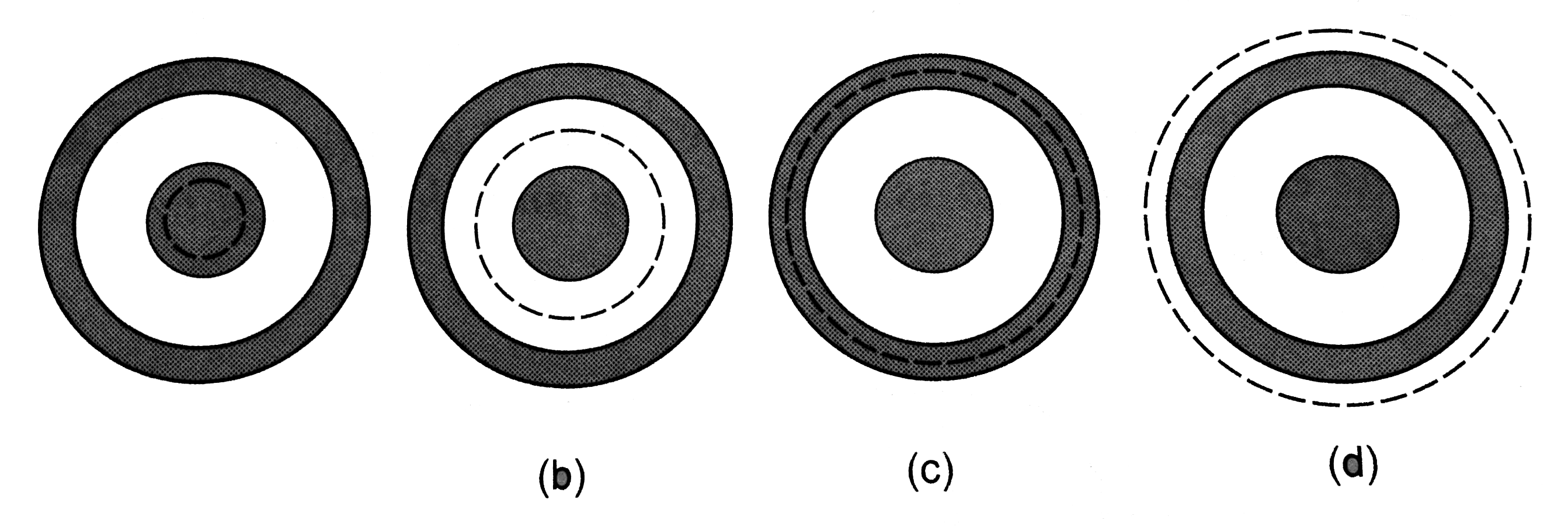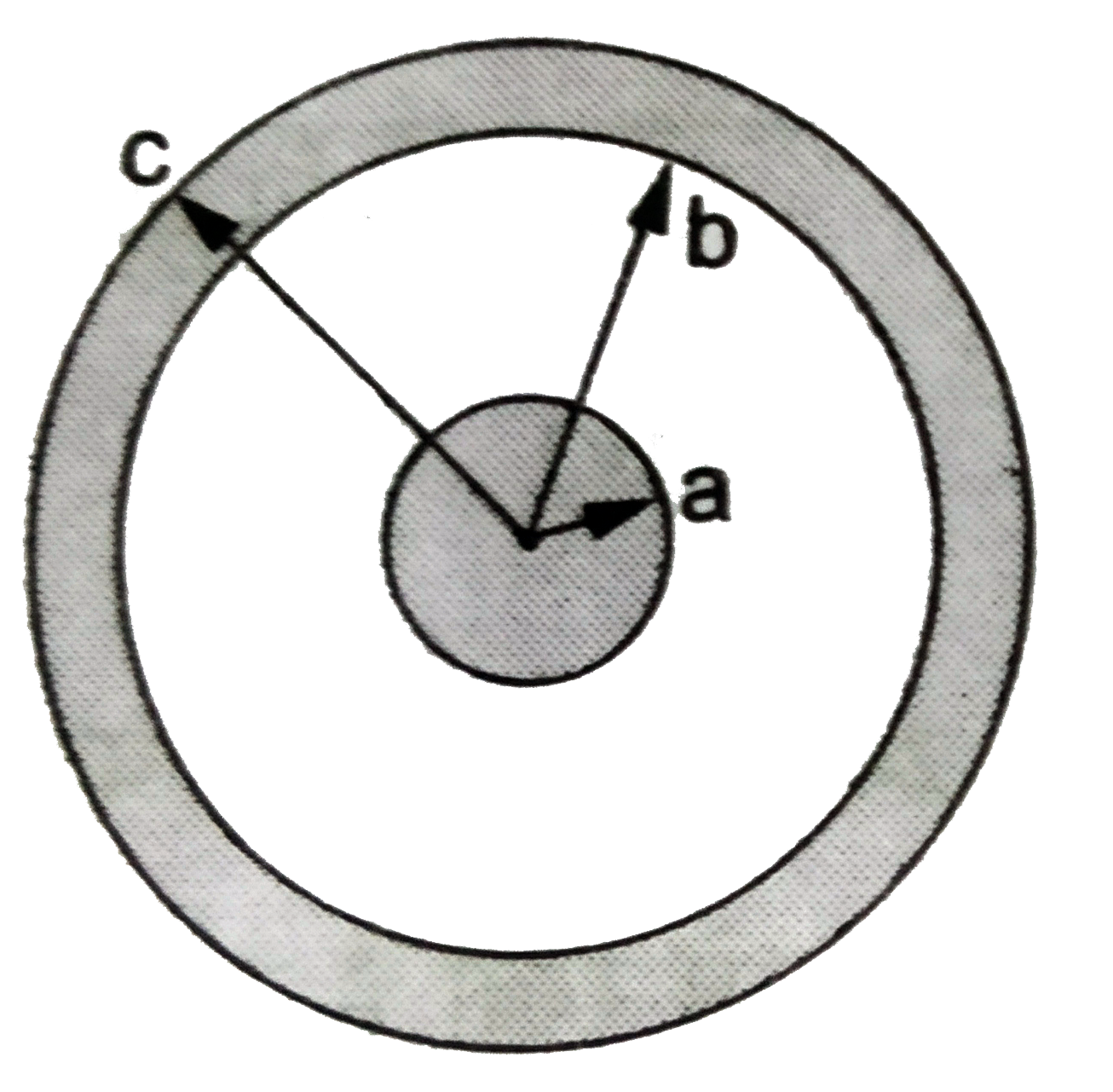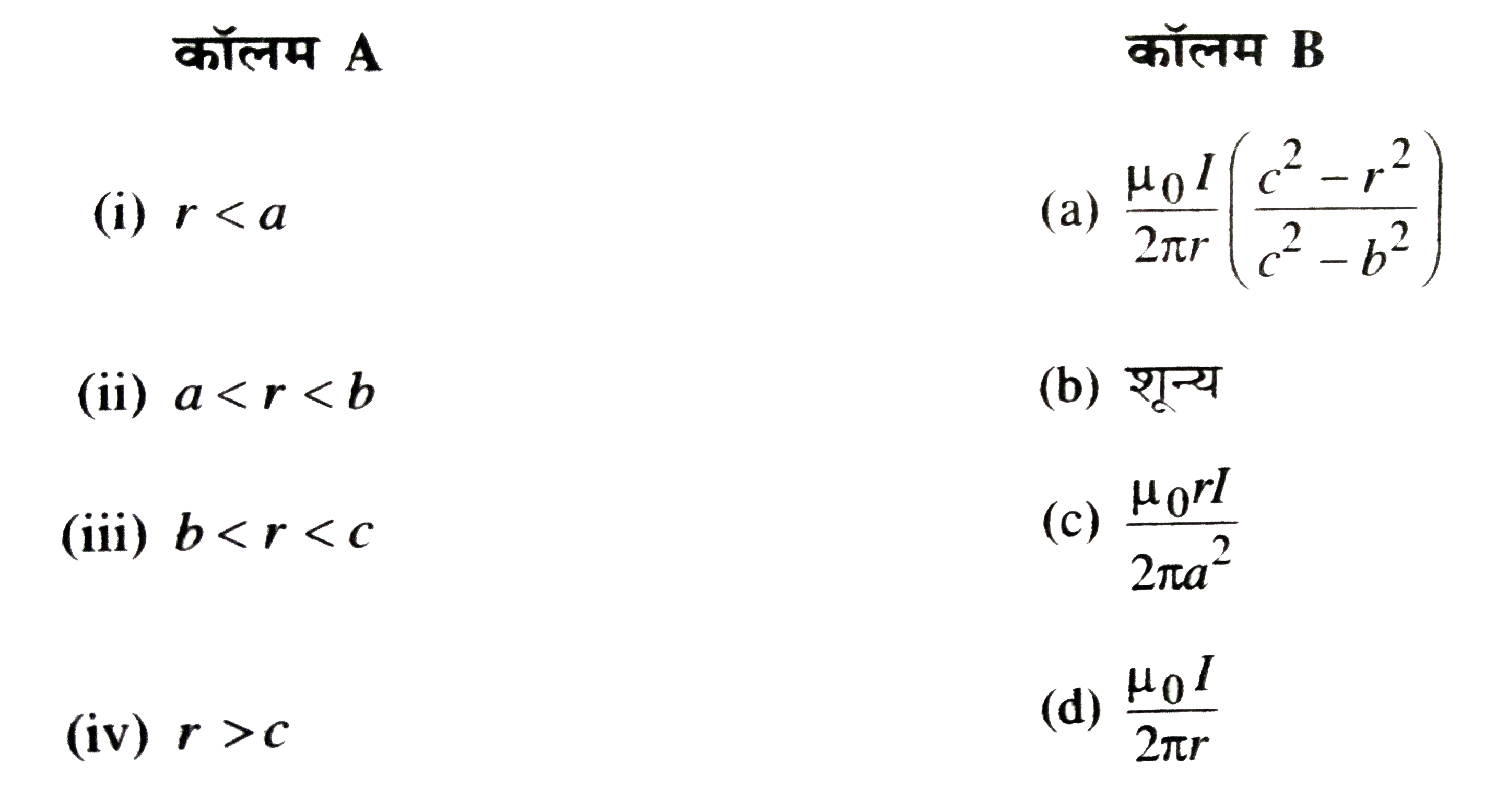Consider a coaxial cable which consists of an inner wire of radius a surrounded by an outer shell of inner and outer radii b and c respectively. The inner wire carries an electric current (i_0) and the outer shell carries an equal current in opposite direction. Find the magnetic field at a distance x from the axis where (a) xlta, (b) altxltb, (c) bltxltc and (d)xgtc. Assume that the current density is uniform in the inner wire and also uniform in the outer shell.
 Solution in Gujrati
Solution in Gujrati
Solution: A cross section of the cable is shown in figure.
Draw a circle of radius x with the centre at the axis of
the cable. The parts a,b,c and d of the figure
correspond to the four parts of the problem.By
symmetry, the magnetic field at each point of a circle
will have the same magnitude and will be tangential to
it. The circulation of B along this circle is, therefore,
∮(→B).→dl=B2πx
in each of the four parts of the figure.
(a)Thecurrentenclosedwith∈the∘≤∈partais
i0(πa)2.πx2=((i0a2)x2).
Ampere'slaw∮(→B).(→dl)=(μ0)igives
B2πx=((m0)(i0)x3a2)orB=((μ0)(i0)x(2πa)2)
The area of cross section of the outer shell is
πc2−πb2.Theareaofcrosssectionoftheoutershell
with∈the∘≤∈partcofthefigureis(πx2−πb2).
Thus,thecurrentthroughthispartis(i0(x2−b2)c2−b2).Thisis
∈theoppositedirection→thecurrent(i0)∈the∈≠r
wire.Thus,the≠tcurrentenclosedbythe∘≤is
(i0)−(i0(x2−b2)c2−b2)=(i0(c2−x2)c2−b2) .
From Ampere's law,
B2πx=((μ0)(i0)c2−x2c2−b2)
or,B=((μ0)(i0)c2−x22πx(c2−b2)).
(d)The≠tcurrentenclosedbythe∘≤∈partdof
the figure is zero and hence
B2πx=0or,B=0.
Topper's Solved these Questions
- BOOK - HC VERMACHAPTER - MAGNETIC FIELD DUE TO CURRENTEXERCISE - Short Answer12videos
MAGNETIC FIELD DUE TO CURRENT
- BOOK - HC VERMACHAPTER - MAGNETIC FIELD DUE TO CURRENTEXERCISE - Objective 112videos
MAGNETIC FIELD DUE TO CURRENT
- BOOK - HC VERMACHAPTER - MAGNETIC FIELD DUE TO CURRENTEXERCISE - Exercises61videos
MAGNETIC FIELD DUE TO CURRENT
- BOOK - HC VERMACHAPTER - MAGNETIC FIELDEXERCISE - Exercises61videos
MAGNETIC FIELD
- BOOK - HC VERMACHAPTER - MAGNETIC PROPERTIES OF MATTEREXERCISE - Exercises9videos
MAGNETIC PROPERTIES OF MATTER
Similar Questions
An electric current flows in a wire from north to south.
What will be the direction of the magnetic field due to this wire at a point.09:19View SolutionA vertical wire carries a current in upward direction. An electron beam sent horizontally towards the wire will be deflected
04:21View SolutionUsing the formulae ((→F)=(→qv)×(→B)and(B=(μ0)i2πr), show that the SI units of the magnetic field B and the permeability constant (μ0) may be written as (NmA−1) and (NA−2) respectively.
05:46View SolutionAn alpha particle is projected vertically upward a speed of 3.0X104kms−1 in a region where a magnetic field of magnitude 1.0 T exists in the direction south to north. Find the magnetic force that acts on the a particle.
03:10View SolutionThe magnetic intensity H at the centre of a long solenoid carrying a current of 2.0A, is found to be 1500Am−1. Find the number of turns per centimetre of the solenoid.
04:44View SolutionConsider a coaxial cable which consists of an inner wire of radius a surrounded by an outer shell of inner and outer radii b and c respectively. The inner wire carries an electric current (i0) and the outer shell carries an equal current in opposite direction. Find the magnetic field at a distance x from the axis where (a) x<a, (b) a<x<b, (c) b<x<c and (d)x>c. Assume that the current density is uniform in the inner wire and also uniform in the outer shell.
 08:46View Solution
08:46View SolutionIn a coaxial, straight cable, the central conductor and the outer conductor carry equal currents in opposite directions. The magnetic field is zero.
View SolutionTwo coaxial solenoids of different radius carry current I in the same direction. vec(F_1) be the magnetic force on the inner solenoid due to the outer one and vec(F_2) be the magnetic force on the outer solenide due to the inner one. Then
03:21View SolutionConsider a ????cable which consists of an inner wilre of radius a surrounded by an outer shell of inner and outer radii b and c respectively. The inner wire caries a current I and outer shell carries an equal and opposite current. The magnetic field at a distance x from the axis where bltxltc is
03:46View SolutionA coaxial cable carries the a current i in the inside conductor of radius a as shown in figure-4.80 and the outer conductor of inner radius b and outer radius c carries a current i' in opposite direction. Find the magnetic induction due to the coaxial cable at distance r from the central axis of the cable for (a) r gt a , (b) a lt r lt b and (c) b gt r gt c
05:49View Solutionकिसी समाक्षीय बेलनाकार केबुल (coaxial cylindrical cable ) के आंतरिक सुचालक कोर की त्रिज्या a है तथा इसके बहरी खोल (outer shell ) की आंतरिक एवं बाह्म त्रिज्याएँ क्रमशः b और c है (c>b) । आंतरिक कोर से प्रवाहित स्थायी विघुत-धारा I है तथा बाह्म खोल से उतनी ही धारा विपरीत दिशा में प्रवाहित होती है । निकाय के उभयनिष्ट अक्ष से r दुरी पर स्थित बिंदु की स्थिति कॉलम A में तथा उसके संगत चुंबकीय क्षेत्र का परिमाण कॉलम B में व्यक्त है ।

 View Solution
View Solutionएक समाक्षीय केबिल में भीतरी तार में i धारा बहती है तथा लौटते समय बाहरी तार में से वापस आती है, तब केबिल के बाहर अक्ष से r दूरी पर । स्थित किसी बिन्दु पर चुम्बकीय क्षेत्र की तीव्रता है
03:15View SolutionIn a coaxial, straight cable, the central conductor and the outer conductor carry equal currents in opposite directions. The magnetic field is zero.
View SolutionTwo coaxial solenoids of different radius carry current I in the same direction. vec(F_1) be the magnetic force on the inner solenoid due to the outer one and vec(F_2) be the magnetic force on the outer solenide due to the inner one. Then
02:52View SolutionTwo coaxial particles of different radius carry currents in the same direction. Considered hatF_1 There is a magnetic force on the inner solenoid due to the outer solenoid and the magnetic force on the outer solenoid due to the inner solenoid. hatF_2 If so:
10:32View SolutionA current of i ampere flows along the inner conductor of a co-axial cable and returns through the outer conductor of the cable .If r1 and r2 are inner and outer radii of the cable, then the magnetic induction at a distance x meter form the cable will be :
06:47View Solution

